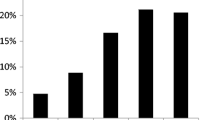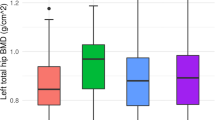Abstract
Summary
We investigated the association of the ulnar styloid fracture (USF) with the bone mineral status and fractured radial displacement in elderly patients. The presence of USF correlates with decreased BMD and severe displacement of the radius. These findings are helpful in treating osteoporosis to prevent subsequent fragility fracture.
Purpose
The pathogenesis of ulnar styloid fracture (USF), which often occurs with distal radius fracture (DRF), is unclear. This study aimed to investigate whether USF concomitant with low-energy DRF was associated with the bone mineral status and the degree of radiographically observed pretreatment radius displacement in Japanese adults above 50 years of age.
Methods
The study subjects were 45 (44 female, 1 male) consecutive patients aged > 50 years with DRF caused by falls from June 2015 to May 2016. Fractures due to high-energy injuries were excluded. Patients were divided into two groups according to the presence or absence of USF. Radius displacement was assessed on anteroposterior and lateral radiographs by measuring ulnar variance, radial inclination, and volar tilt at initial examination before manual reduction of the bone. Bone mineral density (BMD) of the lumbar spine, femoral neck, and distal radius was also measured by dual-energy X-ray absorptiometry within 1 week of injury.
Results
Significant differences in the BMD values of femoral neck, ulnar variance, radial inclination, and volar tilt were found between patients with USF and those without USF (all comparisons, p < 0.05). Logistic regression analysis of all subject data identified that volar tilt was significantly associated with the presence of USF (p = 0.048).
Conclusions
The presence of USF in low-energy DRF correlates with the decreased BMD of femoral neck and severe displacement of radius in elderly patients. These findings are helpful for the treatment of osteoporosis to prevent subsequent fragility fracture.

Similar content being viewed by others
References
Sakuma M, Endo N, Oinuma T, Miyasaka D, Oguma Y, Imao K, Koga H, Tanabe N (2014) Incidence of osteoporotic fractures in Sado, Japan in 2010. J Bone Miner Metab 32:200–205. https://doi.org/10.1007/s00774-013-0486-1
Tsukutani Y, Hagino H, Ito Y, Nagashima H (2015) Epidemiology of fragility fractures in Sakaiminato, Japan: incidence, secular trends, and prognosis. Osteoporos Int 26:2249–2255. https://doi.org/10.1007/s00198-015-3124-z
Yuan C, Zhang H, Liu H, Gu J (2017) Does concomitant ulnar styloid fracture and distal radius fracture portend poorer outcomes? A meta-analysis of comparative studies. Injury 48:2575–2581. https://doi.org/10.1016/j.injury.2017.08.061
Ayalon O, Marcano A, Paksima N, Egol K (2016) Concomitant ulnar Styloid fracture and distal radius fracture portend poorer outcome. Am J Orthop 45:34–37
Sakai A, Oshige T, Zenke Y, Suzuki M, Yamanaka Y, Nakamura T (2008) Association of bone mineral density with deformity of the distal radius in low-energy Colles' fractures in Japanese women above 50 years of age. J Hand Surg [Am] 33:820–826. https://doi.org/10.1016/j.jhsa.2008.02.014
Ting BL, Walley KC, Travison TG, Rozental TD (2017) Elevated bone turnover markers are associated with distal radius fractures in premenopausal women. J Hand Surg [Am] 42:71–77. https://doi.org/10.1016/j.jhsa.2016.12.003
World Health Organization (1994) Assessment of fracture risk and its application to screening for postmenopausal osteoporosis. Report of a WHO study group. World Health Organ Tech Rep Ser 843:1–129
Goldfarb CA, Yin Y, Gilula LA, Fisher AJ, Boyer MI (2001) Wrist fractures: what the clinician wants to know. Radiology 219:11–28. https://doi.org/10.1148/radiology.219.1.r01ap1311
Kanda Y (2013) Investigation of the freely available easy-to-use software 'EZR' for medical statistics. Bone Marrow Transplant 48:452–458. https://doi.org/10.1038/bmt.2012.244
Finnes TE, Lofthus CM, Meyer HE, Eriksen EF, Apalset EM, Tell GS, Torjesen P, Samuelsen SO, Holvik K (2014) Procollagen type 1 amino-terminal propeptide (P1NP) and risk of hip fractures in elderly Norwegian men and women. A NOREPOS study. Bone 64:1–7. https://doi.org/10.1016/j.bone.2014.03.010
Bauer DC, Garnero P, Harrison SL, Cauley JA, Eastell R, Ensrud KE, Orwoll E, Osteoporotic Fractures in Men Research G (2009) Biochemical markers of bone turnover, hip bone loss, and fracture in older men: the MrOS study. J Bone Miner Res 24:2032–2038. https://doi.org/10.1359/jbmr.090526
Hagino H, Yamamoto K, Ohshiro H, Nakamura T, Kishimoto H, Nose T (1999) Changing incidence of hip, distal radius, and proximal humerus fractures in Tottori prefecture, Japan. Bone 24:265–270
Steiger P, Cummings SR, Black DM, Spencer NE, Genant HK (1992) Age-related decrements in bone mineral density in women over 65. J Bone Miner Res 7:625–632. https://doi.org/10.1002/jbmr.5650070606
Rozental TD, Johannesdottir F, Kempland KC, Bouxsein ML (2018) Characterization of trabecular bone microstructure in premenopausal women with distal radius fractures. Osteoporos Int 29:409–419. https://doi.org/10.1007/s00198-017-4293-8
Liu XS, Stein EM, Zhou B, Zhang CA, Nickolas TL, Cohen A, Thomas V, McMahon DJ, Cosman F, Nieves J, Shane E, Guo XE (2012) Individual trabecula segmentation (ITS)-based morphological analyses and microfinite element analysis of HR-pQCT images discriminate postmenopausal fragility fractures independent of DXA measurements. J Bone Miner Res 27:263–272. https://doi.org/10.1002/jbmr.562
Adams BD, Samani JE, Holley KA (1996) Triangular fibrocartilage injury: a laboratory model. J Hand Surg [Am] 21:189–193. https://doi.org/10.1016/s0363-5023(96)80099-2
Gerdhem P, Ivaska KK, Alatalo SL, Halleen JM, Hellman J, Isaksson A, Pettersson K, Vaananen HK, Akesson K, Obrant KJ (2004) Biochemical markers of bone metabolism and prediction of fracture in elderly women. J Bone Miner Res 19:386–393. https://doi.org/10.1359/JBMR.0301244
Acknowledgments
We would like to thank Editage (www.editage.jp) for the English language editing.
Author information
Authors and Affiliations
Corresponding author
Ethics declarations
Conflict of interest
None.
Ethical approval
“All procedures performed in studies involving human participants were in accordance with the ethical standards of the institutional research committee and with the 1964 Helsinki declaration and its later amendments or comparable ethical standards.”
Informed consent
“Informed consent was obtained from all individual participants included in the study.”
Additional information
Publisher’s note
Springer Nature remains neutral with regard to jurisdictional claims in published maps and institutional affiliations.
Rights and permissions
About this article
Cite this article
Yoda, T., Watanabe, K., Shirahata, M. et al. Association between bone mineral density and ulnar styloid fracture in older Japanese adults with low-energy distal radius fracture. Arch Osteoporos 15, 51 (2020). https://doi.org/10.1007/s11657-020-00724-5
Received:
Accepted:
Published:
DOI: https://doi.org/10.1007/s11657-020-00724-5




